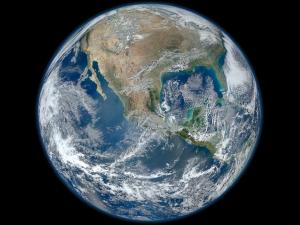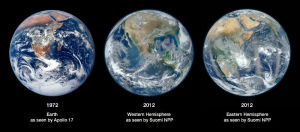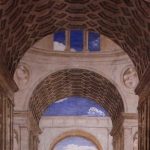
 Our Faculty Voices series invites Pacifica faculty and alumni into engaged conversation, a community call-and-response to which all are invited.
Our Faculty Voices series invites Pacifica faculty and alumni into engaged conversation, a community call-and-response to which all are invited.
Opening to the animae mundi
Tom Elsner | Core Faculty, Pacifica Counseling Psychology Program
| originally posted on 27 Feb 2012
•|•|•|•
On 24 January 2012, NASA released an image of the western hemisphere of the earth as seen from space — “Blue Marble 2012” — that instantly went viral on the internet. According to Flickr, “The western hemisphere Blue Marble 2012 image has rocketed up to over 3.1 million views making it one of the all time most viewed images on the site after only one week.”

Because of the overwhelming public response, NASA then released the flip side view of “Blue Marble,” of the eastern hemisphere not visible in the first photo, and this went viral as well. The original image ≥http://earthobservatory.nasa.gov/IOTD/view.php?id=1133≤ of “Blue Marble” was taken by the crew of Apollo 17 while on the way to the moon in 1972 from 28,000 miles above the earth. The new version was taken January 4, 2012 by a satellite orbiting the earth from a distance of 512 miles, the Suomi National NPP satellite, and was collated from six orbits of this satellite around the globe.

Myths come from conscious and unconscious realizations of some kind that have to find expression in symbolic form and then grip the collective imagination. Joseph Campbell speculated in his famous The Power of Myth interviews with Bill Moyers that, although the emergence of new mythologies is just as unpredictable as dreams, the new myth of our contemporary world might have something to do with the image of the earth as seen from outer space. This image of the globe might inspire intuitions, emotions, and ideas that could find expression in many different aspects of human social life. A myth of the planet as a whole may be, according to Campbell, the future myth, emerging out of necessity, as a means to help guide us in our journey towards both meaning and survival as a species, taking us out of dangerous tribal and national identifications for instance.
Campbell | The only myth that is going to be worth thinking about in the immediate future is one that is talking about the planet, not the city, not these people, but the planet, and everybody on it. And what it will have to deal with will be exactly what all myths have dealt with — the maturation of the individual, from dependency through adulthood, through maturity, and then to the exit; and then how to relate to this society and how to relate this society to the world of nature and the cosmos… But the society that it’s got to talk about is the society of the planet. And until that gets going, you don’t have anything.
Moyers | So you suggest that from this begins the new myth of our time?
Campbell | Yes, this is the ground of what the myth is to be. It’s already here: the eye of reason, not one of nationality; the eye of reason, not of my religious community; the eye of reason, not of my linguistic community. Do you see? And this would be the philosophy for the planet, not for this group, that group, or the other group. When you see the earth from the moon, you don’t see any divisions there of nations or states. This might be the symbol, really, for the new mythology to come. That is the country that we are going to be celebrating.
(Campbell & Moyers, 1991, p. 41).
Contemporary fascination with the planet — politically, ecologically, and psychologically — has been at the center of the mission of Pacifica Graduate Institute since its inception. Our motto is “Animae Mundi Colendae Gratia” — the care of the soul in and of the world. Pacifica’s first graduate program, the M.A. in Counseling Psychology, had its beginning in 1982, the same year that James Hillman published his essay “Anima Mundi: The Return of the Soul to the World.” Originally given as an lecture in Italian translation at the Palazzo Vecchio in Florence, Italy, this influential essay expressed a vision of the return of psychic depths to both the natural and cultural worlds, a vision which is perceived through aesthetic awareness and not cognitive interpretations, a breathing in of the world, a gasp felt in the heart as the seat of imagination, an animal capacity for sensate awareness, and a language filled with concrete images that echo the world.
Hillman’s title to his forward to Roszak’s classic work Ecopsychology in 1995 was “A Psyche the Size of the Earth.” Hillman’s work on anima mundi builds on Jung’s experience of the collective unconscious as a world in which the ego is contained, a world larger than the individual and larger than the human, which includes the non-human animal, and even inorganic matter, and psyche/matter mysteries.
Von Franz commented in the film The Way of the Dream that dreams are the voice of cosmic matter in us. What is the dream of the earth, anima mundi, saying to us today? What is the response of nature to our political, social, psychological, and environmental crises? What is the response of what Jung called the “great Dream”?
Jungian Analyst Theodor Abt published a dream of a 51-year old European man that expresses the potential for humans to find a basis for living together in the global village:
I am at the inauguration of a mosque, which is at the same time also like a Christian basilica, a Jewish synagogue, but also like the church of the village where I grew up. It seemed to be in fact a house of God for everybody, like the house of God of the global village. The king was now on his way to inaugurate this house of God by inserting a huge black cubic basalt, diorite or — I thought when waking up — pyrite stone, over 10 meters in length, into a hole prepared for it that was exactly the size of the stone. The inserted stone was then the floor in front of the prayer-niche or altar, which was, however, just a white linen screen…
Commenting on this part of the dream, Abt wrote in Corpus Alchemicum Arabicum IB: Book of the explanation of the symbols of the “basis of the future centre of the global village, where we have to learn to live together with different images of God, that everyone, for him-or-herself, can project onto the white linen screen that is now the altar. The unifying quality of the black stone means that the common basis of a real world community will be a becoming conscious that we all have to see that our common basis is our own shadow that goes under the earth …” (p. 278)
Ten days after 9/11 an American man dreamt that in order to help with the conflict between the United States and the Middle East he would have to drink his own blood.
Jung wrote, “If the projected conflict [war] is to be healed, it must return into the psyche of the individual, where it had its unconscious beginnings. He must celebrate a Last Supper with himself, and eat his own flesh and drink his own blood, which means that he must recognize and accept the other in himself.” (CW 14, par. 512) Jung was very passionate about his conviction that the world will never reach a state of order until enough people become conscious of, and learn to deal with, the psychological shadow that is typically seen only in an “axis of evil” outside our individual and national selves.
The dream that became Pacifica — animae mundi colendae gratia — began in these Depth Psychological roots: opening to animae mundi, turning towards the otherness of the shadow — mythic ideas that seem to be increasingly necessary for the ecological and political survival of our global village today. And the legacy of Depth Psychology that you inherit and continue to work with, whether in consulting rooms as clinical counselors and psychologists, out in the field of social, political, and environmental activism, or in the continuing articulation and expression of the mythic vision in the creative arts and sciences, builds on that foundation.
I feel privileged and excited to be the first faculty blogger on this new Pacifica Alumni website. For those of you who do not know me, I am a core faculty member in the Counseling Psychology program and a Jungian analyst. I teach courses on the psychological interpretation of fairytales, on alchemy, and Jungian Psychology here are Pacifica. I invite you to think of this first blog entry as an opportunity to continue the dialogue around this dream that is Pacifica with faculty. In upcoming blog entries, various faculty members will be here sharing something of their creative work in the field and looking forward to hearing about your work, your ideas, and to continuing their collaboration with you through this new forum of the Alumni Association.
Towards that end a couple of upcoming events that I will be involved with out in the world include the 12th annual “Jung in Ireland” seminars presented by the New York Center for Jungian Studies, 15-22 April 2012, and a presentation at the C.G. Jung Society of Lafayette, LA, 4-5 May 2012. It would be great to see PGI Alumni at these events!
I look forward to hearing from you and about what you are up to.





